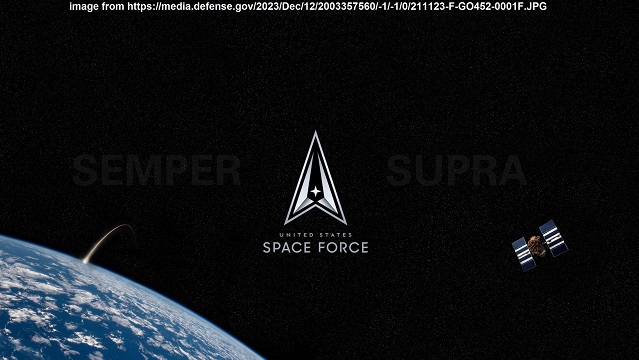
The U.S. Space Force has chosen Texas A&M to lead one of two new space strategic technology institutes.
Directing the $37.6 million dollar, five year partnership of nine institutions and representatives of the private sector is the chairman of A&M’s mechanical engineering department.
Dr. Rob Ambrose told WTAW News that the focus of their work involves space robotics and spacecraft operations for the Space Force.
Ambrose says what the Space Force “really wanted was to make sure that any new ideas that we developed in a university setting can get infused into a current proposal or an activity at one of the big companies that are building spacecraft for them” (the Space Force).
What Ambrose describes as a “dream team” from partner universities will “bring ideas to A&M (and) we’ll be able to test them on our spacecraft simulator. And then this is the exciting part, if any of that actually works we can transfer them to companies and to the Space Force labs where they can be tested on actual spacecraft.”
Specifics on the institute, according to a news release from the Space Force, says the A&M led group “will focus on procurement of technologies relating to spaceflight experimentation and space-related signal, energy, and transportation technologies.”
Additionally, the Space Force says “Focus areas for the selected proposals include researching robotic servicing and associated modeling and simulation, developing testbeds, as well as CubeSat berthing and refueling technologies, developing constructive operations, large-scale in-space assembly, and debris mitigation.”
Click below to hear comments from Rob Ambrose, visiting with WTAW’s Bill Oliver.
Listen to “U.S. Space Force chooses Texas A&M to lead a new institute” on Spreaker.
News release from the Texas A&M system:
The United States Space Force has chosen Texas A&M University to lead the Space Strategic Technical Institute for In-Space Operations (SSTI-ISO), a groundbreaking initiative to advance technologies for in-space operations.
SSTI-ISO will develop new in-space operations, infuse new technologies into industrial efforts and government laboratories and provide access to workforce, talent and subject matter experts for defense space missions.
Dr. Robert Ambrose, J. Mike Walker ’66 Chair Professor in the Mechanical Engineering Department at Texas A&M and Director for Space and Robotics Initiatives for the Texas A&M Engineering Experiment Station, will lead SSTI-ISO as director.
“No university is better equipped for aeronautics and space projects than Texas A&M,” said John Sharp, chancellor of Texas A&M University System. “We thank General B. Chance Saltzman and the U.S. Space Force for trusting us with this important responsibility.”
With Texas A&M as the lead university, most of the testing will be performed in a dual spacecraft testbed located at the Texas A&M-RELLIS campus. At the end of last year, Gen. B. Chance Saltzman, chief of space operations for the U.S. Space Force, toured the RELLIS campus and its cutting-edge facilities to hear about the ongoing innovative research.
“As a space-grant institution, Texas A&M has a long history of conducting world-class research and technological innovation in space exploration,” said General (Ret.) Mark A. Welsh lll, president of Texas A&M University. “This announcement not only acknowledges that Texas A&M is at the vanguard of space science and engineering, but it also emphasizes the exceptional quality of our world-class faculty. We are grateful to the U.S. Space Force for providing us with the opportunity to continue our work in this vital domain.”
SSTI-ISO, a collaborative effort involving leading academic institutions and industry partners, has been awarded $37.6 million for a 5-year project. Led by Texas A&M University, the team also includes researchers and students from the University of Southern California, the University of Texas at Austin, Purdue University, Carnegie Mellon University, the University of New Mexico, the University of Texas at El Paso, Prairie View A&M University and the Southwest Research Institute, amassing over 400 years of combined experience in the space sector.
“This is a real dream team for in-space operations,” Ambrose said. “These are professors that I have known for decades in some cases, and I’m really excited to bring everyone together to help the Space Force with its important mission in space.”
SSTI-ISO has garnered significant support from leading space industrial partners, including Northrop Grumman, Lockheed Martin, Intuitive Machines, Blue Origin, Lunar Resources, Novium, Aegis, and Axiom Space, all of whom have signed letters of support for the project.
“We will conduct extensive testing for the team here, evaluating and refining their ideas and algorithms for maturation and use by our industry partners,” Ambrose said. “We will be doing a lot of integrated testing.”
More than 50 students and researchers across all member institutions will collaborate on innovative in-space operations with customer and industrial partners.
“Texas A&M University Engineering stands at the forefront of space research, uniting academic excellence, industry collaboration and cutting-edge research,” said Dr. Joe Elabd, interim vice chancellor and dean of Texas A&M Engineering. “This convergence positions the university as a nexus of exploration, pushing the boundaries and advancing the forefront of space exploration.”
News release from the U.S. Space Force:
The United States Space Force selected two institutions under the Space Strategic Technology Institute, or SSTI 2, to facilitate applied research in the areas of In-Space Operations, which includes Space Access, Mobility, and Logistics, or SAML.
In partnership with the Air Force Research Laboratory, USSF has selected the following lead institutions to receive a combined total of $49.9 million:
– University of Cincinnati
– Texas A&M University
This opportunity, pursuant to the In-Space Servicing, Assembly, and Manufacturing National Strategy, will focus on procurement of technologies relating to spaceflight experimentation and space-related signal, energy, and transportation technologies.
Focus areas for the selected proposals include researching robotic servicing and associated modeling and simulation, developing testbeds, as well as CubeSat berthing and refueling technologies, developing constructive operations, large-scale in-space assembly, and debris mitigation.
This effort coincides with Space Force’s involvement in the Consortium for Space Mobility and ISAM Capabilities, or COSMIC, kickoff event, Nov. 7-8, 2023, and will contribute to the national coalition in what Chief of Space Operations Mobilization Assistant Maj. Gen. John Olson referred to as a “WeSAM” approach.
About Space Strategic Technology Institutes: The United States Space Force is establishing Space Strategic Technology Institutes to address space Science and Technology challenges through a network of partnered universities. Space Force envisions the institutes will facilitate and focus joint applied research on transformational space domain technology breakthroughs and developments that lead to the advancement of capabilities that can be transitioned and integrated into current and future USSF and U.S. government space capabilities. It is highly desired for the research to lead to testbeds, high fidelity modeling and simulations, demonstrations, and prototypes. The research is expected to transition technology to higher technology readiness levels throughout the period of performance, and out years will be awarded based on an evaluation of this ability. A link to the RFI solicitation is available here.
About Consortium for Space Mobility and ISAM Capabilities: The Consortium for Space Mobility and ISAM Capabilities is a U.S., nationwide coalition that will invigorate domestic In-space Servicing, Assembly, and Manufacturing capability.
COSMIC’s mission is to make ISAM a routine part of space architectures and mission lifecycles to achieve the benefits described in the ISAM National Strategy (April, 2022). Goals will be approached in three thrusts: capability development, ecosystem economics and mission applications.
